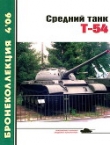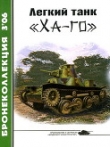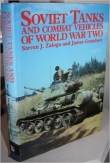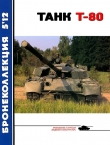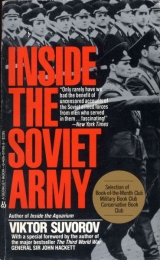
Текст книги "Inside The Soviet Army"
Автор книги: Viktor Suvorov
Жанр:
Публицистика
сообщить о нарушении
Текущая страница: 9 (всего у книги 26 страниц)
The Airborne Forces
1
The Airborne Forces (ABF) do not rank as one of the Armed Services but as an arm of service. However they are an independent arm of service, and do not belong to any of the Armed Services. In peacetime they are subordinated directly to the Minister of Defence and in wartime to the Supreme Commander.
At present there are only 13 formations in the world which one can call `Airborne Divisions'. The US, West Germany, France, China and Poland each have one. The remaining 8 belong to the Soviet Union.
The airborne divisions are directed, for both administrative and operational purposes, by a Commander. His post is of unique importance. Although he commands only 8 divisions, he has the rank of General of the Army, the same as that held by the Commander-in-Chief of the Land Forces, who has 170 divisions under his command.
In peacetime, all the ABF divisions are up to their full wartime complement and staffed by the best troops. The ABF have first choice of personnel, before even the Strategic Rocket Forces and the Navy's submarine detachments.
ABF troops may operate under the control of the C-in-C of Strategic Directions, in groups of 1 to 3 divisions, or they may function independently.
If 1 to 3 divisions are to be used for an airdrop in a particular sector their operations are coordinated by an ABF corps command group, which is established temporarily for this purpose. One of the ABF Commander's deputies commands the corps. If 4 or 5 divisions are to be used, a temporary ABF Army command group is established. This may be headed by the Commander of the ABF himself, or by one of his deputies.
The entire strength of Military Transport Aviation of the Air Forces is controlled by the Commander of the ABF while an airborne assault operation is taking place.
Each-ABF division consists of:
Three parachute regiments
A reconnaissance battalion (18 armoured reconnaissance vehicles)
A battalion of self-propelled artillery (32 airborne assault guns)
An anti-tank battalion (18 85mm guns)
A howitzer battalion (18 122mm guns)
A battalion of multiple rocket launchers (18 BM 27-Ds)
An anti-aircraft battalion (32 ZSU-23–4s)
A communications battalion
A motor transport battalion
A battalion responsible for the storage and packing of supply-dropping parachutes
A chemical warfare company
An engineer company
A parachute regiment has three battalions and mortar, anti-aircraft, anti-tank, and self-propelled artillery batteries.
All the battalions in one regiment of a division are equipped with BMD-1 armoured personnel carriers. Two other regiments have one battalion each of BMD-1s and two of light motor vehicles. Thus, of the nine parachute battalions in a division, five have armoured vehicles of great manoeuvrability and considerable fire-power, the remaining four have light vehicles. In all, a parachute division has 180 armoured personnel carriers, 62 self-propelled guns, 18 multiple rocket launchers, 36 field guns, 45 mortars, 54 anti-aircraft guns, more than 200 anti-aircraft rocket launchers and more than 300 anti-tank rocket launchers. The division is fully motorised, with more than 1,500 vehicles. Its average peacetime complement is 7,200.
3
There has been discussion for some considerable time, in both the Soviet General Staff and the Central Committee, of the question of transforming the ABF into a sixth, independent Armed Service.
It is envisaged that such a Service would have four or five parachute divisions, a large contingent of transport aircraft, several newly-established divisions of marine infantry, units of landing ships and several aircraft carriers with fixed-wing aircraft and helicopters.
Experience has shown that the USSR has not enough forces equipped and trained for armed intervention in a territory which is separated from it by an ocean and that it is unprepared for such an undertaking. There are many examples-Cuba, Indonesia, South Africa, Chile, Central America. A new Armed Service of the sort described would enable the Soviet Union to intervene effectively in such areas.
As its internal crises become more acute, the aggressiveness of the Soviet Union increases. For this reason it appears probable that the sixth Armed Service will be created in the next few years.
Military Intelligence and its Resources
1
Soviet Military Intelligence is neither an Armed Service nor an Arm of Service. It has no uniform or identifying badge or emblem. Nor are these needed. Intelligence is a logistical support service, like the services concerned with nuclear warheads or camouflage or disinformation.
All these services are secret and do not need publicity. Each of them adopts the appearance of the unit in which it finds itself and becomes indistinguishable from it.
Soviet military intelligence is a gigantic organisation, which performs a vast range of tasks. In numbers and technical equipment it is approximately the size of the Bundeswehr-the entire armed services of the Federal German Republic.
In action, decisions are taken by commanding officers, ranging from those in charge of sections to the Supreme Commander. The plans on which these decisions are based are prepared for the commanding officer by his staff. He then either approves the plan or rejects it and orders that another one should be prepared. All commanding officers from battalion level upwards have staffs. The chief of staff is both his commander's principal adviser and his deputy. Staffs vary in size according to the importance of the unit-a battalion has a staff of two, and the General Staff numbers tens of thousands. In spite of this, the work of any staff proceeds according to the same plan.
The first officer on the staff plans operations, the second officer provides him with the information he needs about the enemy. The chief of staff coordinates the work of these two, helps them, checks their work, prepares a plan with their help and presents it to the commander, who either accepts or rejects it.
On a battalion staff the chief of staff and the first officer are one and the same. The staff of a regiment consists of a chief of staff, a first officer and a second officer, who is in charge of intelligence work. On a divisional staff the first and second officers have their own working groups. An Army staff has first and second departments. The staff of a Front and of a Strategic Direction has First and Second Directorates. The General Staff has First and Second Chief Directorates.
Staffs also have other departments, directorates or Chief Directorates but the work of the first component-planning-and of the second-intelligence-form the backbone of any staff.
All intelligence work (which includes reconnaissance) from battalion level to the very top, is thus wholly in the hands of the staff officers concerned and represents one of the most important components of the work of the staff.
Those employed on intelligence and reconnaissance work can be divided into `professionals'-those whose basic function it is-and `amateurs'-those who are employed on intelligence work from time to time and for whom it is an additional rather than their main occupation.
The intelligence and reconnaissance resources of a battalion are not large. A motor-rifle battalion has a mortar battery, with a command platoon, which includes an artillery reconnaissance section. This section works for the mortar battery, reporting all the results which it obtains both to the battery commander and to the second officer on the battalion's staff, who is responsible for all reconnaissance work in the battalion. This is all. All the personnel involved are `professionals'. In a tank battalion there is no mortar battery and therefore no `professionals'. But there are `amateurs'. In each motor-rifle or tank battalion the second company, besides carrying out its normal duties, is trained for reconnaissance operations behind the enemy's lines. During an action any of the platoons of the second company may be detailed for reconnaissance tasks for the battalion. Sometimes the whole second company may be detached to carry out reconnaissance tasks for the regiment.
2
The second officer on the staff of a regiment has the title `Regimental Intelligence Officer'. He is a major and the resources at his disposal are not inconsiderable.
Directly under his command is the regiment's reconnaissance company, which has 4 tanks, 7 armoured vehicles (BMP `Korshun' or BRDM-3) and 9 motorcycles.
In addition the regiment has an artillery battalion, anti-tank, rocket and anti-aircraft batteries. All these have resources sufficient to meet their own requirements for artillery reconnaissance and observation and the information which they produce is also sent to regimental headquarters.
The regiment also has an engineer company with a reconnaissance platoon and a chemical warfare company with a CW reconnaissance platoon. The specialised reconnaissance activities of these platoons are of primary benefit to the engineer and CW companies but since they are engaged in reconnaissance they are controlled by the regimental intelligence officer (RIO).
Finally, the latter is in charge of the second officers on the staffs of the regiment's battalions. These officers work for their battalions but are subordinated to and fully controlled by the RIO. During combat operations, at the direction of the commander of the regiment, the `amateur' companies from any of the battalions can be subordinated to the RIO, to work for the regiment as a whole. Thus, the regiment's `professional' reconnaissance company may be joined at any time by a second tank company and by the three second companies from the motor-rifle battalions.
In a battle, a regiment's reconnaissance companies operate at ranges of up to 50 kilometres away. Both the `professional' and the `amateur' companies have BMP or BRDM vehicles for CW, engineer and artillery reconnaissance work. The fact that these vehicles are always with what are purely reconnaissance sub-units has led to the idea that they are an integral part of these units. But this is not so. The CW reconnaissance platoon is taken from the CW company, the engineer reconnaissance platoon from the engineer company and so forth. Quite simply, it would be both pointless and dangerous to send special reconnaissance sub-units behind the enemy lines unprotected. For this reason they always operate with normal tank and motor-rifle reconnaissance sub-units, which protect and are temporarily in command of them.
During reconnaissance operations, all reconnaissance sub-units work covertly, keeping away from concentrations of enemy troops and always avoiding contact. They operate to achieve surprise, working from ambushes to capture prisoners and documents and they also carry out observation of the enemy. They accept battle only when they clash unexpectedly with the enemy, and if it is impossible to avoid contact or to escape. If they do find themselves in contact with superior numbers of the enemy they will often disperse, meeting again some hours later at an agreed spot in order to resume their mission.
There is one situation in which reconnaissance sub-units would accept battle, whatever the circumstances. If they encountered enemy nuclear forces (missile launchers, nuclear artillery, convoys or stores of nuclear warheads) they would report that they had located the target, would discontinue their reconnaissance mission and would launch a surprise attack on the enemy, with all their resources, whatever this might cost and whatever the strength of the enemy's defences.
3
A divisional intelligence officer-the second officer on a divisional staff-has the rank of lieutenant-colonel. He has very considerable resources at his disposal. In the first place he is in charge of all the regimental intelligence officers, in the division, with all their subordinates, both `professional' and `amateur'. He supervises artillery reconnaissance and observation, which in a division is already of sizeable proportions. He is also in charge of the engineer reconnaissance company of the division's sapper battalion and of the CW reconnaissance company in the division's CW protection battalion. In addition, he has personal control of the division's reconnaissance battalion.
To coordinate the workings of all these resources (more than a thousand `professionals' and more than fifteen hundred `amateurs') a divisional intelligence officer has a group of officers, which has the designation `Second Group of the Divisional Staff'.
The reconnaissance battalion of a division is made up of the division's best soldiers and officers-the fittest, toughest, most quick-witted and resourceful. It has four companies and auxiliary sub-units.
The first of these, a long-range, reconnaissance company, is the smallest and the most ready for battle of the 166 companies and batteries in the division. It has a strength of 27, 6 of whom are officers and the remainder sergeants. It has a commander, a company sergeant-major and five long-range reconnaissance groups each consisting of an officer and four sergeants. These groups can operate far behind the enemy lines. They may be landed by helicopter or may push through into the enemy's rear in jeeps or light armoured vehicles after following close behind their own troops and then passing them and moving on far ahead. Long-range reconnaissance groups are used both to gather intelligence and to carry out diversionary and terrorist operations.
The battalion's second and third companies have the same organisational structure as the reconnaissance companies of regiments and use the same equipment and tactics, but unlike them they operate at distances of up to 100 kilometres ahead of the front line.
The fourth company is the `radio and radar reconnaissance' or signals intelligence company. Its function is to detect and locate enemy radio transmitters, to intercept and decipher their transmissions and to locate, identify and study the enemy's radar stations. In peacetime, the great majority of these companies are already on an operational footing. In the Group of Soviet Forces in Germany, for instance, there are 19 tank and motor-rifle divisions. These contain 19 reconnaissance battalions, each of which has one signals intelligence company. All these companies have been moved, in peacetime, up to the border with West Germany and are working at full stretch, twenty-four hours a day, collecting and analysing any radio signal which is transmitted in their operational area. The same applies to all the other, similar companies of the divisions which are stationed on Soviet territory and in all the frontier military districts. In a number of cases, the signals intelligence companies of divisions in military districts away from the frontier have been moved into frontier districts and are working operationally, supplementing and duplicating the work of other similar companies.
The second officer of the staff of an Army has the rank of colonel. To control the Army's reconnaissance work he has his own department, the Second Department of the Army Staff. Because an Army has so many reconnaissance resources and because these differ so widely one from the other, the department is divided into four groups.
The first group is concerned with the reconnaissance activity of the motor-rifle and tank divisions of the Army and also of the Army's independent brigades and regiments.
Army reconnaissance departments have no second group.
The third group is concerned with diversionary and terrorist operations. Under its control is an independent SPETSNAZ company, the organisation and functions of which have already been discussed.
The fourth group deals with the processing of all the information which is received.
The fifth group directs radio and radar reconnaissance. It controls two electronic intelligence battalions. It also coordinates the operations carried out in this field by the Army's divisions. Needless to say, all signals intelligence battalions are working operationally in peacetime. In East Germany, for instance, there are 5 Soviet Armies, that is to say 10 electronic intelligence battalions, which keep a constant watch on the enemy, in addition to the 19 companies which are on the strength of the divisions of these Armies.
5
A Front is made up of two or three all-arms armies and of a tank and an air army. It possesses a large quantity of reconnaissance resources-enough to equal the intelligence services of a large European industrial state.
The second officer of a Front's staff is a major-general. To control the reconnaissance and intelligence activities of the Front he has a reconnaissance directorate (the Front's Second Directorate), which has five departments.
The first of these controls the reconnaissance work of all the Armies belonging to the Front, including that carried out by the Air Army, which we have already discussed.
The second department carries out agent work, for which it maintains an Intelligence Centre, working on behalf of the Armies making up the Front, since these do not run agents, and three or four intelligence outposts. The centre and the outposts are hard at work, in peacetime, obtaining intelligence in the territory in which the Front would operate in wartime. The Soviet Army has a total of 16 military districts, 4 groups of forces, and 4 fleets. Each of these has a staff with a Second Directorate, which itself has a second department. There are thus 24 of these; each of them constitutes an independent agent running intelligence organisation, which is active on the territories of several foreign countries, working separately from any other similar services. Each of them has four or five individual agent-running organisations which seek to recruit foreigners who will work for the Front or for its tank armies, fleet, flotilla or all-arms armies.
The third department of each of these 24 Reconnaissance Directorates concerns itself with diversionary and terrorist activities. The department supervises activity of this sort in the armies of the Front but also has its own men and equipment. It has a SPETSNAZ diversionary brigade and a SPETSNAZ diversionary agent network of foreign nationals, who have been recruited to work for the Front in the latter's operational area in wartime. Thus, in both peace and wartime the officer in charge of the reconnaissance and intelligence work of a Front or Fleet has two completely separate secret networks, one, which gathers intelligence, controlled by the second department of the Directorate and another, concerned with diversionary and terrorist operations, which is subordinated to the third department.
The fourth department collates all the reconnaissance and intelligence material which is produced.
The fifth department is concerned with the radio and reconnaissance work of the divisions and armies and also has two regiments and a helicopter squadron of its own which also carry out signals intelligence operations.
6
A Strategic Direction is made up of four Fronts, one Fleet and a Group of Tank Armies. Its staff contains a Reconnaissance Directorate, headed by a lieutenant-general. We already know that he has at his disposal a diversionary SPETSNAZ long-range reconnaissance regiment, containing Olympic medal-winners, most of whom are not only professional athletes but professional killers. The Reconnaissance Directorate also has an entire range of reconnaissance and intelligence-gathering equipment, one of which deserves special mention.
This is the `Yastreb' pilotless rocket aircraft, which is launched from a mobile rocket launcher and which carries out photo – and radio-reconnaissance at heights of more than 30 kilometres, flying at speeds in excess of 3,500 kilometres per hour. From Byelorussia the `Yastreb' has successfully carried out photographic reconnaissance over Spain, Great Britain and the French Atlantic seaboard. Its appearance at the beginning of the 1970s caused alarm at NATO headquarters. It was mistakenly identified as a MIG-25R. After a MIG 25 had appeared in Japan and had been carefully examined, the experts came to the conclusion that this aircraft had insufficient operational radius to fly over Western Europe. It was realised that there had been a false alarm and in order not to cause another one the Soviet Union discontinued flights by the `Yastreb' in peacetime. However, it is still being used over China, Asia and Africa and over the oceans. Having the invulnerability of a rocket and the precision of an aircraft, the `Yastreb' would also make an excellent vehicle for a nuclear warhead. Unlike a rocket it can be used again and again.
7
The second officer of the General Staff has the title of Head of the Chief Intelligence Directorate (GRU). He is a full General of the Army. Besides controlling the intelligence and reconnaissance resources subordinated to him, he has his own, incomparably huge intelligence network. The GRU works for the Supreme Commander. It carries out espionage on a scale unparalleled in history. It is enough to record that during World War II the GRU was able, with its own resources, to penetrate the German General Staff from Switzerland and to steal nuclear secrets from the United States, and that after the war it was able to induce France to leave NATO, besides carrying out many less risky operations. The work of the GRU's agent networks is controlled by the first four Directorates, each of which is headed by a lieutenant-general. The processing of all information reaching the GRU is carried out by an enormous organisation which is grouped into six Information Directorates. Today the Head of the GRU has two separate, world-wide, intelligence organisations, a colossal number of electronic intelligence centres, centrally controlled diversionary units and so on and so forth.
However, the Chief Intelligence Directorate of the General Staff is a subject which calls for a substantial book to itself.
8
Staffs are of different types. The smallest is that of a battalion, the largest is the General Staff. But each has its own intelligence and reconnaissance resources, just as each brain has its own eyes and ears. The higher staffs control the lower ones and the corresponding higher intelligence organisations direct those below them. At all levels, the intelligence and reconnaissance organisations work for their respective staffs, but if intelligence which is received is of interest to either a higher or a lower echelon, it is passed on immediately.
Here is a particularly interesting example of such coordination.
In the summer of 1943, the Red Army was preparing to halt the enormously powerful German advance. In the Kursk salient seven Soviet Fronts were simultaneously preparing their defences.
The overall coordination of operations in the Strategic Direction was in the hands of Marshal G. K. Zhukov. Never in the history of warfare had such a defence system been set up, on a front more than a thousand kilometres in length. The overall depth of the obstacles erected by the engineers was 250–300 kilometres. On an average, 7,000 anti-tank and anti-personnel mines were laid along every kilometre of the front. For the first time the AT artillery density reached 41 guns per kilometre. In addition, field guns and anti-aircraft guns were brought up for use against tanks. It was already impossible to break through such a front. Nevertheless, the German command decided to try to do so. But, they were only able to bring together a million men and officers to carry out the operation, and they were unable to achieve surprise. On the night of 5 June a reconnaissance group from one of the thousands of Soviet battalions captured a German lance-corporal who had been clearing a passage through barbed wire obstacles. The Soviet battalion was immediately put on the alert and the second officer on its staff decided to inform the regimental intelligence officer of what had happened. The regiment was brought to battle readiness straight away and the news of the capture of the lance-corporal was transmitted to the intelligence group of the divisional staff and from there to the staff of the corps, to the staff of the 13th Army, straight from there to the Central Front headquarters and thence to the Headquarters of the Strategic Direction, to Marshal Zhukov and finally to the Chief Intelligence Directorate of the General Staff. It took twenty-seven minutes for the message to pass from the battalion staff to the Chief Intelligence Directorate. The news was astonishing. If the enemy was clearing passages through barbed wire, he must be preparing to advance. But only an immense offensive could be contemplated against such a mighty defensive system. And immense it was-but it ended in complete disaster.

